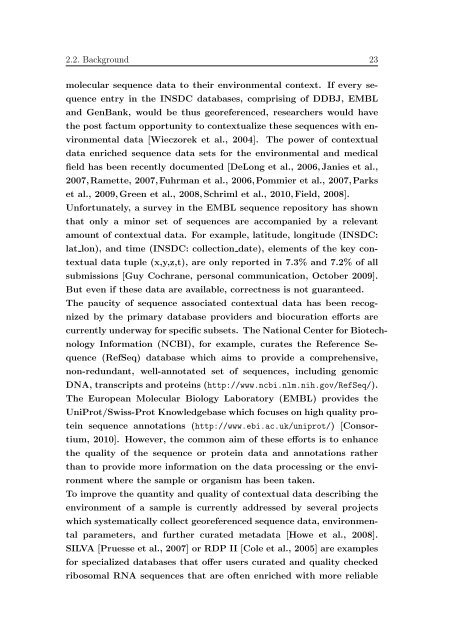Data integration in microbial genomics ... - Jacobs University
Data integration in microbial genomics ... - Jacobs University
Data integration in microbial genomics ... - Jacobs University
You also want an ePaper? Increase the reach of your titles
YUMPU automatically turns print PDFs into web optimized ePapers that Google loves.
2.2. Background 23<br />
molecular sequence data to their environmental context. If every sequence<br />
entry <strong>in</strong> the INSDC databases, compris<strong>in</strong>g of DDBJ, EMBL<br />
and GenBank, would be thus georeferenced, researchers would have<br />
the post factum opportunity to contextualize these sequences with environmental<br />
data [Wieczorek et al., 2004]. The power of contextual<br />
data enriched sequence data sets for the environmental and medical<br />
field has been recently documented [DeLong et al., 2006, Janies et al.,<br />
2007, Ramette, 2007, Fuhrman et al., 2006, Pommier et al., 2007, Parks<br />
et al., 2009, Green et al., 2008, Schriml et al., 2010, Field, 2008].<br />
Unfortunately, a survey <strong>in</strong> the EMBL sequence repository has shown<br />
that only a m<strong>in</strong>or set of sequences are accompanied by a relevant<br />
amount of contextual data. For example, latitude, longitude (INSDC:<br />
lat lon), and time (INSDC: collection date), elements of the key contextual<br />
data tuple (x,y,z,t), are only reported <strong>in</strong> 7.3% and 7.2% of all<br />
submissions [Guy Cochrane, personal communication, October 2009].<br />
But even if these data are available, correctness is not guaranteed.<br />
The paucity of sequence associated contextual data has been recognized<br />
by the primary database providers and biocuration efforts are<br />
currently underway for specific subsets. The National Center for Biotechnology<br />
Information (NCBI), for example, curates the Reference Sequence<br />
(RefSeq) database which aims to provide a comprehensive,<br />
non-redundant, well-annotated set of sequences, <strong>in</strong>clud<strong>in</strong>g genomic<br />
DNA, transcripts and prote<strong>in</strong>s (http://www.ncbi.nlm.nih.gov/RefSeq/).<br />
The European Molecular Biology Laboratory (EMBL) provides the<br />
UniProt/Swiss-Prot Knowledgebase which focuses on high quality prote<strong>in</strong><br />
sequence annotations (http://www.ebi.ac.uk/uniprot/) [Consortium,<br />
2010]. However, the common aim of these efforts is to enhance<br />
the quality of the sequence or prote<strong>in</strong> data and annotations rather<br />
than to provide more <strong>in</strong>formation on the data process<strong>in</strong>g or the environment<br />
where the sample or organism has been taken.<br />
To improve the quantity and quality of contextual data describ<strong>in</strong>g the<br />
environment of a sample is currently addressed by several projects<br />
which systematically collect georeferenced sequence data, environmental<br />
parameters, and further curated metadata [Howe et al., 2008].<br />
SILVA [Pruesse et al., 2007] or RDP II [Cole et al., 2005] are examples<br />
for specialized databases that offer users curated and quality checked<br />
ribosomal RNA sequences that are often enriched with more reliable

















